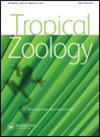The potential role of night-time lighting in attracting terrestrial insects as food for Oreochromis mossambicus and Clarias gariepinus
IF 0.4
4区 生物学
Q4 ZOOLOGY
引用次数: 4
Abstract
This study investigated the potential of night-time lighting in enhancing the utilization of aerial insects by Oreochromis mossambicus and Clarias gariepinus. Six treatments L0 (Light with no fish), N0 (No light, with no fish), LT (Light with O. mossambicus), NT (No light with O. mossambicus), LC (Light with C. gariepinus) and NC (No light with C. gariepinus) were randomly assigned to aquadams and replicated three times. Two hundred O. mossambicus (60 ± 0.6 g) and 100 C. gariepinus (90 ± 0.8 g) were stocked to assigned aquadams. Two other treatments designated FT (O. mossambicus fed on pellets) and FC (C. gariepinus fed on pellets), were added. SGR was higher (0.31 g/day) in O. mossambicus subjected to night-time lighting than those that were not (0.05 g/day). C. gariepinus under the night-time lighting also had a higher SGR (0.30 g/day) than the ones that were not (0.26 g/day). However, in both species the growth rate was lower when compared to those fed on commercial pellets. Oreochromis mossambicus benefited more from night-time lighting. The most abundant aerial insects were moths and beetles. The serial slaughter method was used to determine the gastric evacuation rate of moths and beetles in O. mossambicus and C. gariepinus. Moths were evacuated faster (−0.235) than beetles (−0.108) in O. mossambicus. In C. gariepinus, the gastric evacuation of moths was also faster (−0.40) than beetles (−0.36). This implies digestion efficiency was higher in moths than beetles. Water physico-chemical variables were analysed once a week and they were not affected by night-time lighting.夜间照明对吸引陆生昆虫为食的潜在作用
本研究调查了夜间照明在提高Oreochromis mossambicus和Clarias gariepinus对空中昆虫利用率方面的潜力。将6个处理L0(无鱼光照)、N0(无光照,无鱼)、LT(有O.mossambicus光照),NT(有O.mossambicus无光照)和LC(有C.gariepinus光照)随机分配到水族箱中,并重复3次。将200只O.mossambicus(60±0.6克)和100只C.gariepinus(90±0.8克)放养到指定的水族箱中。添加了另外两种处理,即FT(用颗粒喂养的O.mossambicus)和FC(用颗粒饲养的C.gariepinus)。在夜间照明条件下,O.mossambicus的SGR(0.31g/天)高于未照明条件下的(0.05g/天)。C.gariepinus在夜间照明下的SGR(0.30g/天)也高于未照明的(0.26g/天)。然而,与商业颗粒喂养的物种相比,这两种物种的生长速度都较低。Oreochromis mossambicus从夜间照明中受益更多。最丰富的空中昆虫是飞蛾和甲虫。采用连续屠宰法测定了O.mossambicus和C.gariepinus中蛾类和甲虫的胃排空率。在O.mossambicus中,蛾类的疏散速度(−0.235)比甲虫类(−0.108)快。在C.gariepinus中,蛾类的胃排空速度(-0.40)也比甲虫(-0.36)快。这意味着蛾类的消化效率高于甲虫。每周分析一次水的物理化学变量,它们不受夜间照明的影响。
本文章由计算机程序翻译,如有差异,请以英文原文为准。
求助全文
约1分钟内获得全文
求助全文
来源期刊

Tropical Zoology
生物-动物学
CiteScore
2.50
自引率
0.00%
发文量
1
审稿时长
>12 weeks
期刊介绍:
Tropical Zoology is an international zoological journal publishing original papers in the field of systematics, biogeography, phylogeny, ecology and conservation of all terrestrial and aquatic animal Phyla from tropical and subtropical areas.
Only papers with new information, high quality and broad interest are considered. Single species description and checklists are not normally accepted. Review papers are welcome. The journal is owned by the Istituto di Ricerca sugli Ecosistemi Terrestri of the Consiglio Nazionale delle Ricerche, Florence, Italy (CNR-IRET) who performs research into the structure and functioning of aquatic and terrestrial ecosystems, focusing in particular on anthropogenic pressure and global change. The knowledge amassed forms the scientific basis for identifying the most appropriate protective and corrective interventions, and provides support for the bodies entrusted with formulating policies for environmental protection and recovery.
 求助内容:
求助内容: 应助结果提醒方式:
应助结果提醒方式:


